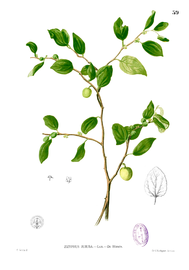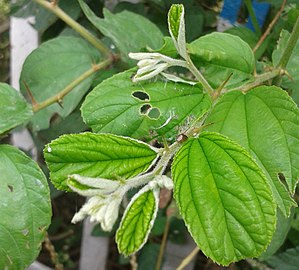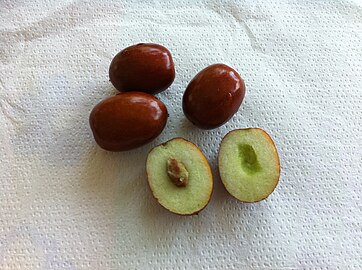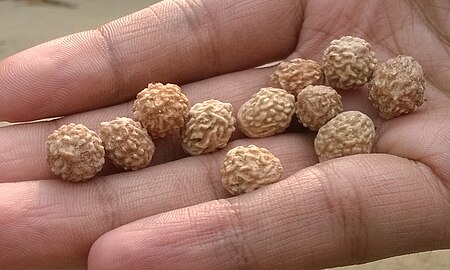Jujube
| Jujube | |
|---|---|

| |
| Ziziphus jujuba, habitus
| |
| Scientific classification | |
| Kingdom: | Plantae |
| Clade: | Tracheophytes |
| Clade: | Angiosperms |
| Clade: | Eudicots |
| Clade: | Rosids |
| Order: | Rosales |
| Family: | Rhamnaceae |
| Genus: | Ziziphus |
| Species: | Z. jujuba
|
| Binomial name | |
| Ziziphus jujuba | |
| Synonyms[2] | |
| |
 Fresh jujube fruit | |
| Nutritional value per 100 g (3.5 oz) | |
|---|---|
| Energy | 331 kJ (79 kcal) |
20.23 g | |
0.2 g | |
1.2 g | |
Niacin (B3) | 6% 0.9 mg |
| Vitamin B6 | 5% 0.081 mg |
| Vitamin C | 77% 69 mg |
| Minerals | Quantity %DV† |
| Calcium | 2% 21 mg |
| Iron | 3% 0.48 mg |
| Magnesium | 2% 10 mg |
| Manganese | 4% 0.084 mg |
| Phosphorus | 2% 23 mg |
| Potassium | 8% 250 mg |
| Sodium | 0% 3 mg |
| Zinc | 0% 0.05 mg |
| Other constituents | Quantity |
| Water | 77.86 g |
| †Percentages estimated using US recommendations for adults,[3] except for potassium, which is estimated based on expert recommendation from the National Academies.[4] | |
 Jujube fruit naturally turns red upon drying. | |
| Nutritional value per 100 g (3.5 oz) | |
|---|---|
| Energy | 1,201 kJ (287 kcal) |
73.6 g | |
1.1 g | |
3.7 g | |
Niacin (B3) | 3% 0.5 mg |
| Vitamin B6 | 0% 0 mg |
| Vitamin C | 14% 13 mg |
| Minerals | Quantity %DV† |
| Calcium | 6% 79 mg |
| Iron | 10% 1.8 mg |
| Magnesium | 9% 37 mg |
| Manganese | 13% 0.305 mg |
| Phosphorus | 8% 100 mg |
| Potassium | 18% 531 mg |
| Sodium | 0% 9 mg |
| Zinc | 2% 0.19 mg |
| Other constituents | Quantity |
| Water | 19.7 g |
| †Percentages estimated using US recommendations for adults,[3] except for potassium, which is estimated based on expert recommendation from the National Academies.[4] | |
Jujube (UK /ˈdʒuːdʒuːb/; US /ˈdʒudʒub/ or /ˈdʒudʒəbiː/[5]), sometimes jujuba, known by the scientific name Ziziphus jujuba and also called red date, Chinese date, and Chinese jujube,[6] is a species in the genus Ziziphus in the buckthorn family Rhamnaceae. It is often confused with the closely related Indian Jujube, Z. mauritiana. The Chinese jujube enjoys a diverse range of climates from temperate to tropical, whereas the Indian jujube is restricted to warmer subtropical and tropical climates.[7]
Description
It is a small
-
Bark
-
Plate from the bookFlora de Filipinas
-
Foliage in Hyderabad, India
-
Leaf margin
-
Flowers
-
Close-up of flowers
-
Fruit
-
Fruit cross section
-
Seeds
Chemistry
Leaves contain saponin and ziziphin, which suppresses the ability to perceive sweet taste.[9]
Taxonomy
The ultimate source of the name is
The binomial name has a curious nomenclatural history, due to a combination of botanical
Distribution and habitat
Its precise natural distribution is uncertain due to extensive cultivation, but its origin is thought to be in
The tree tolerates a wide range of temperatures and rainfall, though it requires hot summers and sufficient water for acceptable fruiting. Unlike most of the other species in the genus, it tolerates fairly cold winters, surviving temperatures down to about −15 °C (5 °F), and the tree is, for instance, commonly cultivated in Beijing. This wide tolerance enables the jujube to grow in mountain or desert habitats, provided there is access to underground water throughout the summer. The jujube (Z. jujuba) grows in cooler regions of Asia. Five or more other species of Ziziphus are widely distributed in milder climates to hot deserts of Asia and Africa.[16]
This plant has been introduced in Madagascar and grows as an invasive species in the western part of the island, threatening mostly protected areas. It is cultivated in parts of southern California.[17]
Ecology

Witch's broom, prevalent in China and Korea, is the main disease affecting jujubes, though plantings in North America currently are not affected by any pests or diseases.[18] In Europe, the last several years have seen some 80%–90% of the jujube crop eaten by insect larvae (see picture), including those of the false codling moth, Thaumatotibia (Cryptophlebia) leucotreta.[19]
In Madagascar, it is widely eaten by free-ranging zebus, and its seeds grow easily in zebu feces.
Cultivation
Jujube was domesticated in South Asia by 9000 BC.[20] Over 400 cultivars have been selected.
The fruit, when the plant is kept as a garden shrub, is picked in the autumn.
Varieties
- Chico (also called GI 7-62) developed by the United States Department of Agriculture (USDA) in the 1950s[21]
- Li, major commercial variety in the US[21]
- Shanxi li, very large fruit[21]
- Lang, major commercial variety in the US[21]
- Sherwood [21]
- Silverhill (also known as Yu and Tigertooth) can be grown in areas with high humidity[21]
- So[21]
- Shui Men[21]
- GA 866[21]
- Honey jar, small juicy fruit[21]
- Sugar cane[21]
- Winter delight, major commercial variety in China[21]
Uses
Culinary
The freshly harvested, as well as the candied dried fruit, are often eaten as a snack, or with coffee. Smoked jujubes are consumed in Vietnam and are referred to as black jujubes.[22] A drink can be made by crushing the pulp in water.[23] Both China and Korea produce a sweetened tea syrup containing jujube fruit in glass jars, and canned jujube tea or jujube tea in the form of teabags. To a lesser extent, jujube fruit is made into juice and jujube vinegar (called 枣 醋 or 红枣 醋 in Chinese). They are used for making pickles (কুলের আচার) in west Bengal and Bangladesh. In Assam it is known as "Bogori" and the pickle, Bogori aachar (বগৰি আচাৰ), is famous. In China, a wine made from jujube fruit is called hong zao jiu (红枣酒).
Sometimes pieces of jujube fruit are preserved by storing them in a jar filled with baijiu (Chinese liquor), which allows them to be kept fresh for a long time, especially through the winter. Such jujubes are called zui zao (醉枣; literally "drunk jujube"). The fruit is also a significant ingredient in a wide variety of Chinese delicacies (e.g. 甑糕 jing gao, a steamed rice cake).
In Vietnam and Taiwan, fully mature, nearly ripe fruit is harvested and sold on the local markets and also exported to Southeast Asian countries.[24] The dried fruit is used in desserts in China and Vietnam, such as ching bo leung, a cold beverage that includes the dried jujube, longan, fresh seaweed, barley, and lotus seeds.[24]
In Korea, jujubes are called daechu (대추) and are used in
In Croatia, especially
On his visit to
In
Traditionally in India, the fruits are dried in the sun and the hard seeds removed, after which the dried flesh is pounded with
In Northern and Northeastern India the fruit is eaten fresh with salt and chilli flakes and also preserved as candy, jam or pickle with oil and spices.
In Madagascar, jujube fruit is eaten fresh or dried. People also use it to make jam. A jujube honey is produced in the Atlas Mountains of Morocco.[24]
Italy has an alcoholic syrup called brodo di giuggiole.[29] In Senegal and The Gambia, Jujube is called Sii dem or Ceedem, and the fruit is used as snack and also turned into a dried paste favoured as a sweetmeat by schoolchildren. More recently it has been processed and sold in Dakar by women.
In Australia jujube beer is made.[30]
The commercial jujube candy popular in movie theaters originally contained jujube juice but now uses other flavorings.
Traditional Chinese medicine
This section needs more
Gan Cao, is used in Chinese medicine to harmonize and moderate other herbs.[citation needed ]
Jujube fruit is also combined with other herbs to treat colds and influenza. The fruit contains many different healthy properties like vitamins, amino acids. The use of the fruit can be helpful for spleen diseases in Chinese medicine.[34] Other usesIn Japan, the natsume has given its name to a style of tea caddy used in the Japanese tea ceremony, due to the similar shape.[35] Its hard, oily wood was, along with pear, used for woodcuts to print books starting in the 8th century and continuing through the 19th in China and neighboring countries. As many as 2000 copies could be produced from one jujube woodcut.[36][verification needed] In China, the leaves are sometimes picked for teas, such as by families in Laoshan Village, Shandong Province, China, where it counts as a variety of herbal tea.[citation needed] The timber is sometimes used for small items, such as tuning pegs for instruments. Select grade Jujube timber is often used in traditional Asian instruments for fingerboard, pegs, rests & soundposts, ribs & necks etc. It has a medium to hard density similar to luthier grade European maple and has excellent tonal qualities. Jujube Wood can be found in local folk instruments from Ceylon/India thru to China/Korea; it is also commonly used in China in violin & cello making for overseas export, though usually stained black to imitate the look of ebony. Luthier grade jujube wood planes and carves beautifully.
CultureIn Arabic-speaking regions the jujube and alternatively the species Z. lotus are closely related to the lote-trees (sing. "سدرة sidrah", pl. " سدر sidr") which are mentioned in the Quran,[37][38] while in Palestine it is rather the species Z. spina-christi that is called sidr.[26] An ancient jujube tree in the city Al-Qurnah, Iraq, is claimed by locals as the Tree of Knowledge mentioned in the Bible.[39][failed verification] Local tradition holds that the place where the city was built was the original site of the Garden of Eden (a passage in the Book of Genesis creation narrative says that a river flowed from the garden and split into Tigris and Euphrates rivers,[40] where is the city currently). The tree is a tourist spot in the town. Jujube tree is important in Hinduism too as Vishnu is worshipped in a major temple, in Badrinath, from the Sanskrit compound Badarīnātha, consisting of the terms badarī (jujube tree) and nātha (lord), an epithet of Vishnu.[41] It is also known as Badarikashrama. See also
References
Further reading
Wikimedia Commons has media related to Ziziphus jujuba. External links |










